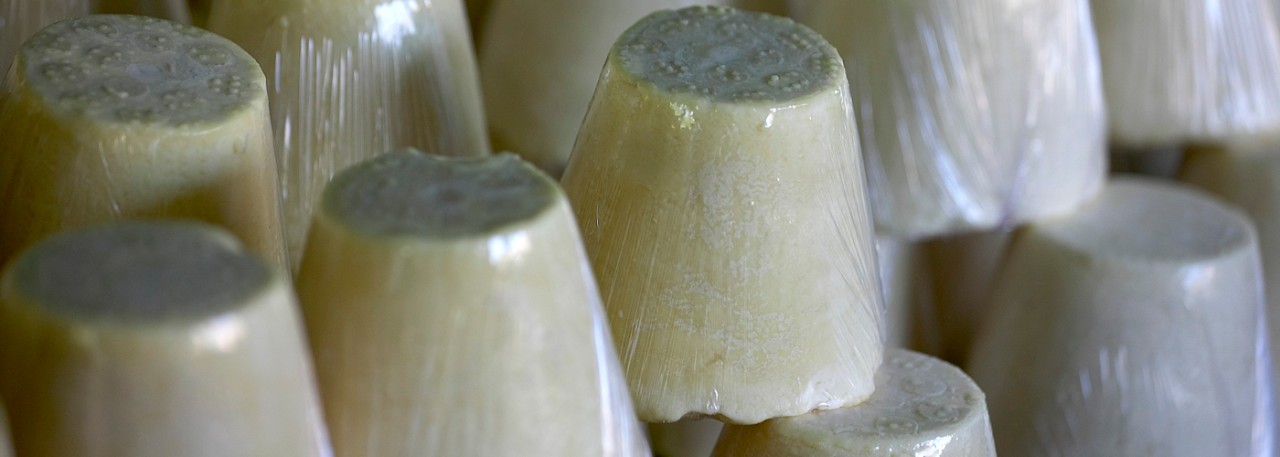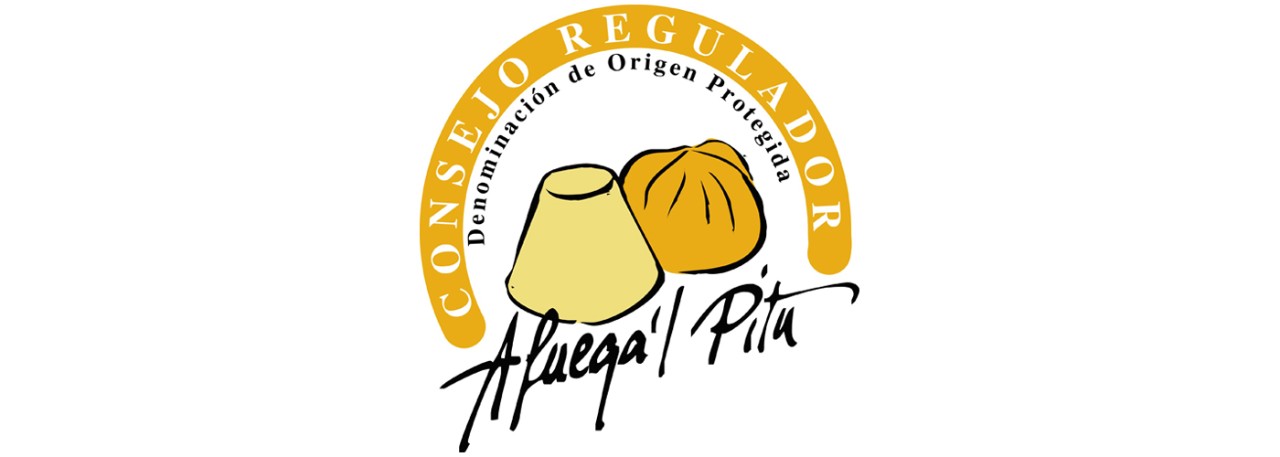.png.transform/rendition-xs/image_image%20(1).png)
Afuega’l Pitu PDO
A soft, full-fat cheese made from pasteurized whole cows’ milk of the Friesian and Asturiana de los Valles breeds. In cheeses that are to be ripened for 60 days pasteurization is not essential.
Tasting notes
The flavor is slightly sharp, and just lightly salted or even bland. The texture is creamy and fairly dry. The red cheese has a strong, piquant flavor, which becomes pasty and astringent as it is swallowed (‘pitu’ is a colloquial term in the Asturian dialect for the pharynx). The aroma is characteristically mild, becoming more marked with ripening. The consistency of the paste starts off being soft and spreadable but, with ripening, it gradually becomes harder and one of this cheese’s main characteristics is its crumbliness, making it impossible to make a clean cut through it.
Other notes
The shape is either a truncated cone when molds are used or a pumpkin shape when the cheese is wrapped in a cloth and tied at the top, leaving the crease marks from the cloth. The height is 5-12 cm / 3-4¾ in for both shapes, with a base diameter of 8-14 cm / 3-5½ in. The weight is 200-600 gr / 7-21 oz.
The rind is natural, of varying consistency depending on the degree of ripening and on whether or not pimentón (a type of Spanish paprika) is added. The cheese may be sold either fresh or ripe and the color is white or yellowish, depending on ripeness, or orangey-red if pimentón is added.
The content is as follows:
- Fat: minimum 45% of dry matter
- Protein: minimum 35% of dry matter
- Dry matter: minimum 30%
- pH: 4.1 to 5
Production / Processing method
The milk, from certified dairies within the production area, is pasteurized at 72ºC / 161ºF for 15 to 30 seconds. However, in cheeses that are to be ripened for 60 days, pasteurization is not essential.
From the pasteurizer or cold tank the milk goes direct to the coagulation vats where the starters are added, sometimes with a very small amount of liquid rennet. The temperature is kept at 22-32ºC / 71-89ºF and coagulation lasts for 15-20 hours.
The curds are then ladled into perforated molds made of food-grade plastic and left to drain for 12 hours. This is a slow process because no pressure is applied, just that of the curds’ own weight.
The molded curds, which now have a much smaller volume having lost much of their moisture, are then transferred to smaller molds and salt (sodium chloride) is added. After twelve hours, they are turned out of the molds and placed on perforated trays for final draining. They are then transferred to the ripening chamber until ready for sale.
When the cheeses are to be made from worked paste, the curds are first left to drain in the molds then, after about 24 hours, they are worked and salt is added and, for the roxu variety, also pimentón. Subsequently, the paste is transferred to molds (for the atroncau roxu variety) or wrapped in cloths (for the de trapu roux variety), and left for a further 24 hours.
The cheeses are then placed on trays in ripening chambers and turned regularly until the desired ripeness is reached. This will last from five to 60 days. The cheeses are sold in the authorized, labeled packs. They must be kept chilled at 4-10ºC / 39-50ºF until sold.
Geography / Relief and climate
The climate is oceanic, with plenty of rainfall all year round, moderate sunshine and plenty of cloud. Average annual rainfall is closely related to the relief and varies from 900 l/m2 in some coastal areas to 2,000 l/m2 in higher mountain areas.
The relief dates from the end of the Primary era about 250 million years ago and was modeled by orogenic movements during the Tertiary, about 50-25 million years ago.
Generally speaking, the relief includes steep slopes along the narrow strip between the coast and the watershed, giving rise to two clearly defined areas at different altitudes - the sea-level strip and the higher parts reaching a maximum height of 1,788 m / 5,866 ft. More than half of the territory is above 400 m / 1,312 ft and more than one quarter above 800 m / 2,624 ft. These altitudes determine the climate, biology and sociology, affecting both pastureland and animal rearing activities.
The soil is slightly acid (pH 6.9-6.5) with a high organic content and fairly balanced levels of nitrogen, phosphorus, magnesium and potassium. These conditions make the local pastures different from those of other geographical areas.
The pastures offer a wide range of species of agricultural interest, such as gramineae, leguminosae and labiates, all excellent feed for cattle.
Regulatory Council
Consejo Regulador de la DOP Afuega’l Pitu
Polígono de Silvota, Parcela 96
33192 Llanera
Asturias
Tel: (+34) 985 264 200
afuegalpitu@doafuegalpitu.es
www.dofuegalpitu.com/
Sources:
- Spanish Ministry of Agriculture
- Regulatory Council, Afuega’l Pitu PDO
The flavor is slightly sharp, and just lightly salted or even bland. The texture is creamy and fairly dry. The red cheese has a strong, piquant flavor, which becomes pasty and astringent as it is swallowed (‘pitu’ is a colloquial term in the Asturian dialect for the pharynx).


- PDO Afuega’l Pitu
- PDO Afuega’l Pitu Log

Llanera (Asturias)
